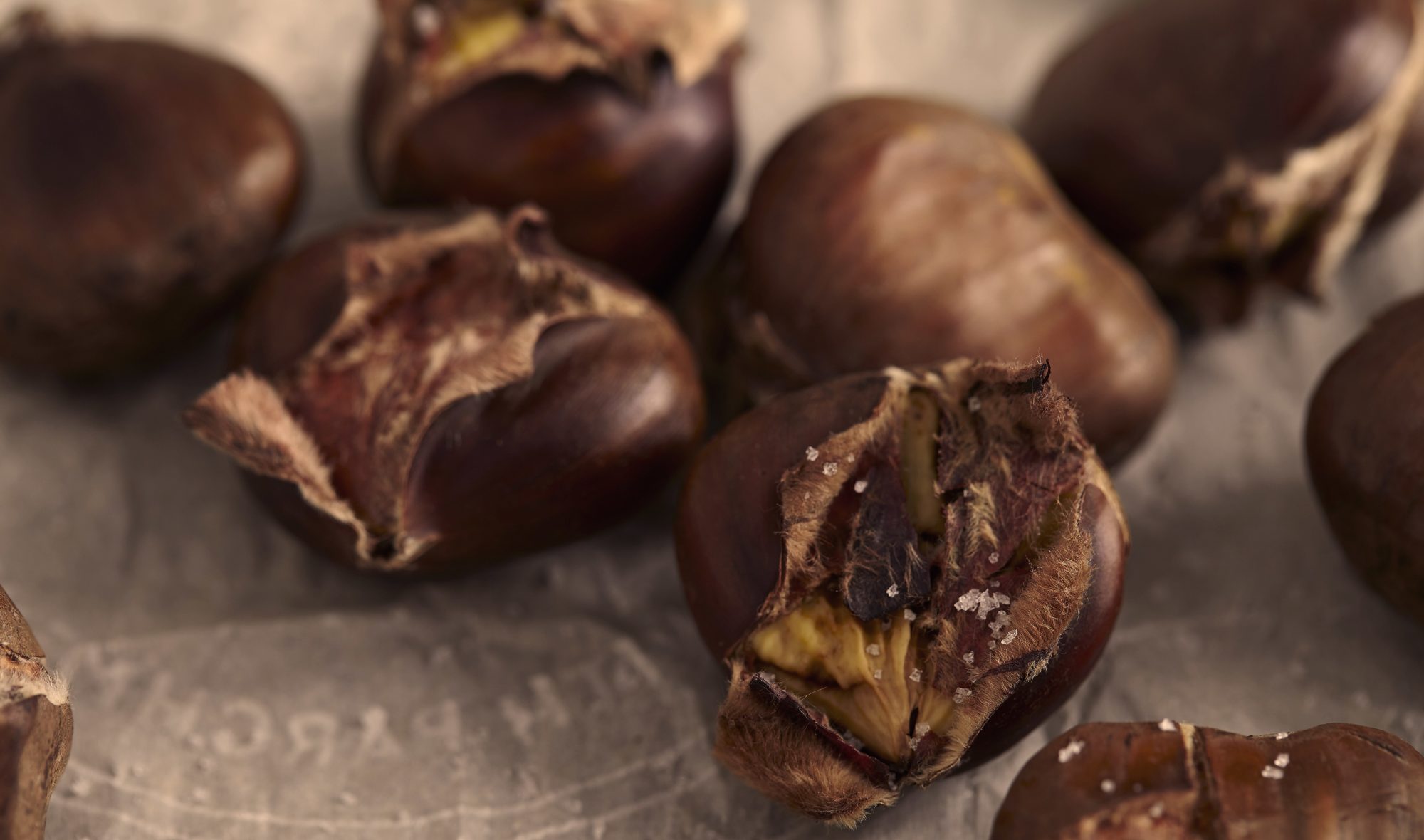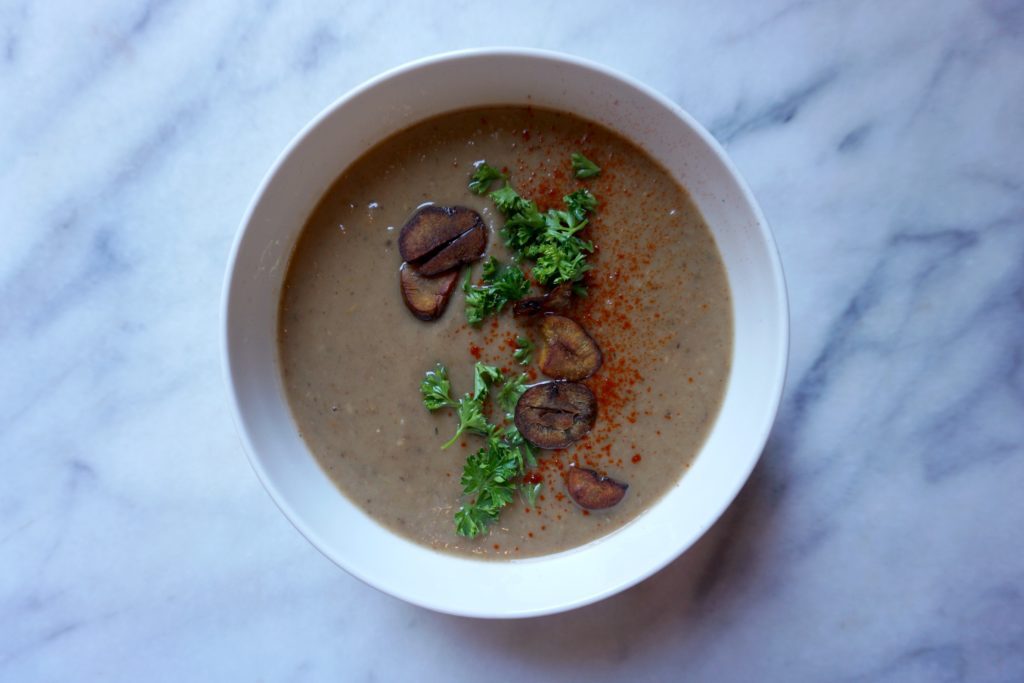
💥 SAVE 54% on the PN Nutrition Certification + Coaching Career Kickstarter Course! Ends Friday.

💥 SAVE 54% on the PN Nutrition Certification + Coaching Career Kickstarter Course!

Chestnuts are an edible nut, which come into season during autumn, and are often associated with fall and winter holidays. Chestnuts are packed with potassium. They also offer folate and vitamin C. The whole nuts must be peeled and cooked before eating (or you can purchase pre-cooked chestnuts). Once cooked, chestnuts have a meaty, slightly starchy, almost creamy texture and a rich flavor that works in both sweet and savory dishes.
Chestnuts are the edible nuts of Chestnut trees (Castanea sativa). Chestnut trees can be found in the US, Europe, China, Japan, and Australia.
Chestnuts, which must be cooked before eating, come into season between October and December. They are often associated with fall and winter holidays: most famously, perhaps, roasted at Christmastime. In Japan, chestnuts are typically included as part of a New Year feast.
Once cooked, chestnuts have a meaty, slightly starchy, almost creamy texture and a rich flavor that works in both sweet and savory dishes.
The edible nuts have several layers covering them. The whole nut is protected by a spikey burr, which turns yellow-brown and splits open at the time of maturity.
Break away the burr and you’ll find the nut’s hard outer shell; this is the way you will commonly find chestnuts. Fresh chestnuts in the shell are plump and rounded with a flat bottom. They have a dark, deep brown color and a glossy sheen.
After removing the shell, there’s one final layer – a thin inner skin – that must be removed before eating. Once shelled, the raw nuts inside are a light, creamy brown color.
Note: You may also find pre-cooked, packaged chestnuts in grocery stores or specialty food shops.
Chestnuts are lower in calories than other nuts, but they are also less nutrient-dense.
Per ounce, roasted chestnuts have about 70 calories, 0.9g of protein, 15g of carbohydrates, 1.4g of fiber, 3g of sugar, and 0.6g of fat.
Chestnuts are packed with potassium (168 grams per ounce). Folate and Vitamin C are also contained in chestnuts.
If choosing whole, raw chestnuts, look for firm, heavy nuts without any cracks, holes or appearance of mold.
To test for freshness, shake the chestnut – if you hear a rattling sound it may be an indication the nut inside is old and dry.
Pre-cooked chestnuts are another option; you may find them in a sealed package or a can. Ensure there are no added ingredients listed on the package.
Note: When looking for pre-cooked chestnuts in the grocery store you may come across chestnuts in syrup or canned chestnut puree; however, both these are sweetened items meant as treats or for use in baking. They are not the same as pure whole chestnuts. Also make sure you are purchasing chestnuts and not water chestnuts, which are a different food altogether.
Store whole, raw chestnuts in the fridge, in an unsealed container, to keep them fresh. This way, they should keep for up to two weeks or more.
Cooked and peeled chestnuts are best eaten within a day or two.
Canned or packaged chestnuts should be eaten before the expiry date listed on the packaging.
Chestnuts must be cooked before eating; otherwise their shells are very difficult to remove and their taste and texture unpleasant.
Chestnuts can be boiled or roasted, then added to other dishes or eaten as a snack.
To prepare chestnuts, first score an X on the flat side of each nut using a sharp paring knife.
To roast the nuts, preheat the oven to 350F. Place the scored nuts on a rimmed baking sheet and bake in the oven for about 35 minutes.
Alternatively, to boil the chestnuts, plunge the scored nuts into a pot of boiling water. Boil until tender, about 15 minutes, then drain.
When the nuts are still hot but cool enough to touch, peel them. They should slip out of their shells with a gentle squeeze. Remove the papery inner skin before eating.
Note: If you’re using pre-packaged chestnuts, the process is much simpler: simply remove from package, drain if canned, and enjoy.
Once prepared, you can eat cooked chestnuts as a snack, or add them to other dishes such as salads, stuffing or dressing, or baked goods. They pair well with fall and winter flavors such as apples, cabbage, turkey, pork, and sage.

This rich and savory chestnut soup gets a hint of caramelized sweetness from roasted parsnips and garlic, and a hint of smokiness from smoked paprika. Garnished with crispy fried chestnut slices and fresh parsley, this makes an elegant, satisfying appetizer or side.
Prep Time: 20 minutes Cook Time: 60 minutes Yield: 6 servings
Preheat oven to 400 degrees Fahrenheit. Line a large baking tray with parchment paper. In a bowl, toss together chopped parsnips, garlic cloves, oil, and salt to coat. Spread mixture out on parchment paper, being careful not to crowd them too much. Place in the preheated oven and bake for 20 minutes. Remove, shuffle around the pieces, and place back in the oven for an additional 10-15 minutes, or until parsnips are soft and golden brown at the edges. Set aside.
In a large pot over medium-high heat, add butter and allow to melt. Add onions and mushrooms and cook until mushrooms are soft and onions are translucent, about 5-7 minutes. Add chestnuts and broth. Before adding the parsnips and garlic, make sure to peel off and discard the coarse garlic skins. Then, add roasted parsnips and soft garlic cloves to the pot too.
Bring pot to a boil then reduce to simmer; allow to simmer for 15 minutes, covered. Then, remove from heat, stir in spices, and allow to cool slightly.
Using an immersion blender or working in batches with a blender, puree the soup until smooth. Season with salt and pepper to taste. Place over low heat while you prepare the toppings, if using.
To make the crispy sliced chestnut topping, add a small pat of butter to a skillet over medium-high heat, and wait until butter is sizzling. Add chestnut slices, and cook until golden and crispy, about 1-2 minutes on each side.
Portion the soup into individual bowls, then garnish with a light sprinkle of smoked paprika, a pinch of minced fresh parsley, and a few crispy chestnut slices. Serve immediately.
Precision Nutrition’s Encyclopedia of Food expands every single month as we highlight new foods and showcase beautiful food photography. If you’d like to stay up to date, simply click this link. From there, we’ll send you a FREE copy of our recipe book. We’ll also let you know when new and delicious foods are added to the site.
Chestnuts are an edible nut, which come into season during autumn, and are often associated with fall and winter holidays. Chestnuts are packed with potassium. They also offer folate and vitamin C. The whole nuts must be peeled and cooked before eating (or you can purchase pre-cooked chestnuts). Once cooked, chestnuts have a meaty, slightly starchy, almost creamy texture and a rich flavor that works in both sweet and savory dishes.